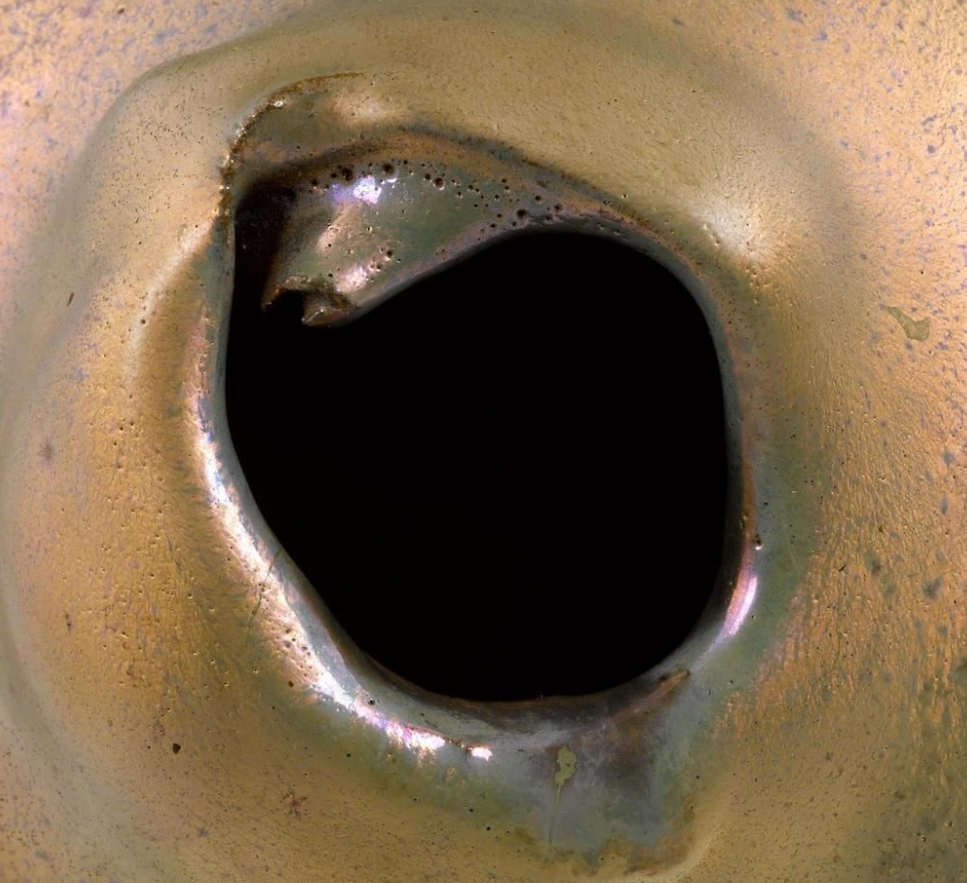The Contemporary Art Auction at Dorotheum (Vienna, November 25, 2015) includes a group of exceptional ceramic works by the Italian modern master, Lucio Fontana who has been setting a hot pace in the resale market for the last five years. What follows are the scholarly entries in the auction house’s catalog. You can also read the blog on Fontana and two videos are posted below.
Above image: Lucio Fontana (Rosario di Santa Fe, Argentina 1899–1968 Comabbio) Concetto Spaziale (detail), 1962/65, signed l. Fontana, holes and graffiti on coloured [luster] glazed ceramic, 25 x 27 x 22.5 cm, (AR) Estimate: EUR 2000,000 to 300,000.

Copyright Archivo Ugo Mulas
As Giulio Carlo Argan wrote, “Fontana’s abstract sculptures are certainly not sculptures. Sculpturally, they are unfinished, nor are they a cultural experience, since the contemporary existence of other, profoundly different works deprives them of their potential significance as a ‘phase of transition’ in the artist’s career. Rather, they more likely ought to be regarded as having experimental value: they are an investigation aimed at determining a new dimension that cannot be defined with the usual categories of depth and planes, and is valid only for the identity of sign and colour it postulates.”

Lucio Fontana (Rosario di Santa Fe, Argentina 1899–1968 Comabbio) Concetto Spaziale, (detail) 1962/65, signed l. Fontana, holes and graffiti on coloured [luster] glazed ceramic, 25 x 27 x 22.5 cm, (AR) Estimate: EUR 2000,000 to 300,000.
In a few cases (such as his “Venezie” cycle from those years) Fontana resorted again to the use of gold, a shimmering, Byzantine gold.
— Luca Massimo Barbero in “The Fontana I love”, Galleria Tonelli, Milan, Studio La Città, Verona, 2015

The work Concetto Spaziale – Natura exemplifies all this very clearly.
In this fascinating egg-shaped sculpture with elegant colouring, all the tenets of Fontana’s poetics converge, such as the search for the infinite empty space beyond matter, the fundamental relationship between light, space and colour, in this case creating magnificent, intriguing changing effects of gold and violet. The smooth, “satin” golden surface is disrupted by a hole at its centre – a crater emerging from the silent matter which, in Fontana’s hands, seems to be alive and boil like magma in perpetuity.
A while ago, a surgeon came to visit me in my studio, and he told me that he was also very capable of making “these holes.” I responded to him that I too can cut off a leg, but I also know that the patient will die of it. If he cuts it, however, it’s a different situation. Fundamentally different. — Lucio Fontana
The experience of sculpture is a salient moment, perhaps the most noteworthy, in Lucio Fontana’s artistic career. His adventure in sculpture is characterised by a constant syncretism between figurative expression and abstract investigation that was probably his true stylistic signature.
From the second half of the 1950s onwards, however, figurative ceramics, heated battles, sacred figures and masks increasingly gave way to Spatialist production and “abstract” sculptures. During this phase, cylindrical vases and ceramic and terracotta plates were left elegantly bare, marked only with holes and scratches in an elegant interplay of signs, light and shadows. At the end of the decade, his “Natures” were born, terracotta or bronze sculptures executed as mono-surface pebbles or complementary bivalve forms that later became “balloons” according to Fontana’s own definition. His Natures mostly corresponded to the cosmic imagination to which the artist often referred.
Concetto Spaziale-Natura appears as an oval, cosmic, monolithic form that is violently divided into two parts and is characterised by an irregular, wavy surface, which seems to boil like magma in the spot where the artist slits it open with a vertical cut. This object – or “Concept” – has something mysterious and primeval. Something celestial.
Those were the years of astonishing technological progress leading to the launch of the first satellite in history in 1957, Sputnik 1, marking the beginning of the era of space exploration. Four years later, Russian cosmonaut Yuri Gagarin became the first human to complete a full elliptical orbit of the Earth on the Vostok I spacecraft. Just like Fontana’s entire output, this work testifies to Fontana’s passion for the mystery of that unknown and boundless place.
I was thinking of those worlds, of the moon with these…holes, this terrible silence that causes us anguish and the astronauts in a new world. And so…in the artist’s fantasy these immense things have been there for years…man arrives, in mortal silence, in this anguish, and leaves a vital sign of his arrival…were these not still forms with a sign of wanting to make inert matter live? — Lucio Fontana, in Carla Lonzi, Autoritratto, p. 389

Lucio Fontana (Rosario di Santa Fe, Argentina 1899–1968 Comabbio) Concetto Spaziale, Natura, 1959, monogrammed L. F. on the reverse, terracotta with slash, 15 x 11.5 x 6.5 cm, (AR) Estimate: EUR 40,000 to 60,000. Click to see a larger image.
The infinite, the inconceivable chaos, the end of figuration, nothingness. — Lucio Fontana

Lucio Fontana (Rosario di Santa Fe, Argentina 1899–1968 Comabbio) Concetto Spaziale, 1954, signed, dated, l. Fontana 54, holes, graffiti and colour on natural terracotta, 25 x 31.5 cm, (AR) Estimate EUR 100,000 to 150,000. Click to see a larger image.
Beyond the perforations, a newly-gained freedom of interpretations awaits us, but also, and just as inevitably, the end of art. — Lucio Fontana





The quote regarding his interaction with the surgeon is a succinct classic . . .